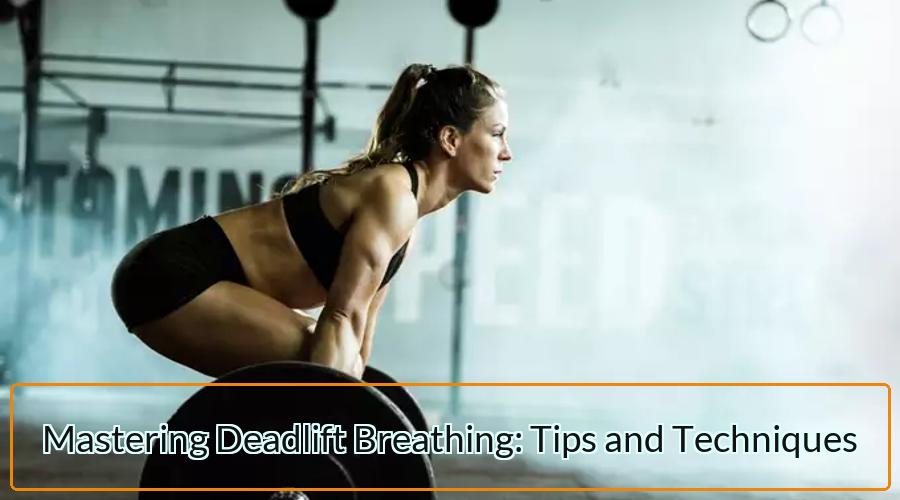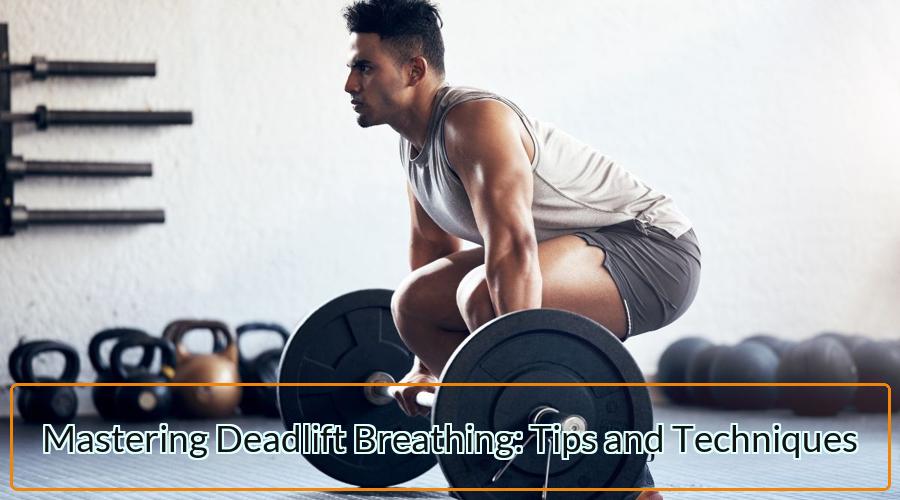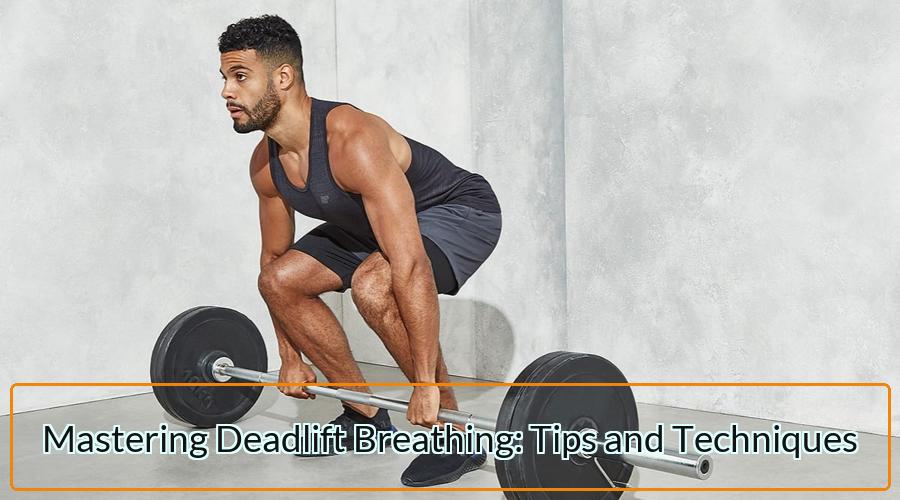
Deadlifts are one of the most effective exercises for building total body strength and power. However, many lifters overlook the importance of proper breathing technique during this exercise. Failing to breathe correctly during deadlifts can lead to decreased performance, as well as an increased risk of injury.
In this blog post, we will explore the importance of deadlift breathing techniques for optimal performance. We will discuss how breathing affects your ability to lift heavy weight, and why proper technique is essential for maximizing results. Additionally, we will provide practical tips and exercises to help you improve your breathing during deadlifts and take your performance to the next level.
Whether you are a seasoned lifter or new to the sport, learning how to breathe correctly during deadlifts is crucial for reaching your goals and avoiding injury. So, let’s dive in and discover the best deadlift breathing techniques for optimal performance.
How Breathing Affects Deadlift Performance
Breathing is a crucial factor in deadlift performance. When executed correctly, proper breathing technique during the deadlift can improve power output, increase muscular endurance, and reduce the risk of injury. Here are some ways breathing affects deadlift performance:
- Core stability: Proper breathing helps to create intra-abdominal pressure, which stabilizes the core and allows for greater force output during the lift. This pressure helps to prevent the spine from collapsing under heavy loads, reducing the risk of injury.
- Power output: The Valsalva maneuver, a breathing technique used during heavy lifts, increases intra-abdominal pressure and creates a more stable core. This stability translates to greater force output and enables lifters to move heavier weights.
- Muscular endurance: Proper breathing technique helps to reduce fatigue during the lift by ensuring that the body is receiving enough oxygen to maintain performance. Breathing also helps to clear carbon dioxide from the body, which can build up during exercise and impair performance.
- Mind-body connection: Focusing on breathing during the lift can help lifters stay present and focused on the task at hand. This mind-body connection can improve technique and overall performance.
Read more about Trenbolone Pills for Sale
The Benefits of Proper Proper Breathing During Deadlifts
Proper breathing technique during deadlifts offers a range of benefits that can improve performance and reduce the risk of injury. Here are some of the top benefits of using proper breathing techniques during deadlifts:
- Increased power output: By stabilizing the core and increasing intra-abdominal pressure, proper breathing techniques can help increase force output during the lift. This can enable lifters to move heavier weights and achieve greater results.
- Enhanced muscular endurance: Proper breathing techniques help to optimize oxygen delivery to the muscles, reducing fatigue and enabling lifters to maintain high levels of performance for longer periods of time.
- Reduced risk of injury: By promoting proper form and spinal stability, proper breathing techniques can reduce the risk of injury during the lift. By creating intra-abdominal pressure, proper breathing also helps to protect the spine and prevent it from collapsing under heavy loads.
- Improved focus and concentration: Focusing on breathing during the lift can help lifters stay present and focused on the task at hand, improving concentration and technique.
- Improved mind-body connection: Breathing is a critical element of the mind-body connection, and proper breathing techniques during deadlifts can help improve this connection. This can lead to better technique, better results, and a greater overall sense of well-being.
In general, proper breathing techniques during deadlifts can lead to increased power output, enhanced muscular endurance, reduced risk of injury, improved focus and concentration, and an improved mind-body connection. By incorporating proper breathing techniques into their deadlift practice, lifters can achieve their goals and reach their full potential.
Techniques for Proper Breathing During Deadlifts
Proper breathing during deadlifts is essential for maximizing performance and reducing the risk of injury. Here are some techniques for proper breathing during deadlifts:
- Breathe in before the lift: Take a deep breath and hold it before initiating the lift. This will create intra-abdominal pressure, which stabilizes the core and protects the spine.
- Exhale during the lift: Exhale during the concentric phase of the lift, or the upward portion. This helps to maintain intra-abdominal pressure and stabilize the core.
- Use the Valsalva maneuver: The Valsalva maneuver involves holding your breath while maintaining intra-abdominal pressure. This technique is particularly useful during heavy lifts and can help increase force output.
- Breathe in during the eccentric phase: During the downward portion of the lift, or the eccentric phase, take a deep breath in. This helps to prepare the body for the next repetition.
- Avoid over-breathing: Over-breathing or hyperventilating can decrease intra-abdominal pressure and reduce spinal stability. Breathe deeply but avoid excessive breathing.
- Focus on timing: The timing of your breathing is critical for proper execution. Take the time to practice breathing technique and ensure that you are breathing at the right times during the lift.
In general, proper breathing during deadlifts involves taking a deep breath before the lift, exhaling during the upward phase, and inhaling during the downward phase. The Valsalva maneuver can be used during heavy lifts, and lifters should avoid over-breathing or hyperventilating. By focusing on timing and practicing breathing techniques, lifters can optimize their breathing and achieve their goals.
Read more about Anavar in UK
Common Mistakes to Avoid in Breathing During Deadlifts
Proper breathing is essential during deadlifts for maximizing performance and reducing the risk of injury. Here are some common mistakes to avoid when breathing during deadlifts:
- Holding your breath for too long: While it’s important to create intra-abdominal pressure, holding your breath for too long can cause dizziness, fainting, or other complications. Make sure to exhale during the upward phase and take a new breath in during the downward phase.
- Over-breathing or hyperventilating: Over-breathing or hyperventilating can reduce intra-abdominal pressure and spinal stability, increasing the risk of injury. Avoid excessive breathing and focus on deep, controlled breaths.
- Breathing at the wrong time: Breathing at the wrong time can cause instability and reduce force output. Make sure to breathe in before the lift and exhale during the upward phase. Inhale during the downward phase to prepare for the next repetition.
- Improper form: Improper form can lead to spinal flexion and increase the risk of injury, regardless of proper breathing technique. Make sure to use proper form and engage the core muscles during the lift.
- Focusing solely on breathing: While proper breathing technique is important, it’s not the only factor in deadlift performance. Make sure to also focus on other elements of proper execution, such as form and grip.
Overall, common mistakes to avoid when breathing during deadlifts include holding your breath for too long, over-breathing or hyperventilating, breathing at the wrong time, improper form, and focusing solely on breathing. By avoiding these mistakes and focusing on proper breathing technique in conjunction with other elements of proper execution, lifters can maximize their performance and reduce the risk of injury.

Exercises to Improve Your Breathing During Deadlifts
Proper breathing during deadlifts is essential for maximizing performance and reducing the risk of injury. Here are some exercises to improve your breathing during deadlifts:
- Diaphragmatic breathing: This exercise involves breathing deeply into the diaphragm, which can help improve overall breathing technique. Lie on your back with your knees bent and your hands on your belly. Breathe in deeply through your nose and feel your belly rise. Exhale slowly through your mouth and feel your belly fall. Repeat for several minutes.
- Core stability exercises: Proper breathing during deadlifts requires a stable core. Exercises like planks, bird dogs, and dead bugs can help improve core stability and support proper breathing.
- Practice lifts: Practicing lifts with lighter weights can help you focus on breathing technique and perfect your form. This can be particularly useful for identifying areas where your breathing technique needs improvement.
- Breathing drills: Incorporate breathing drills into your warm-up and cool-down routines to improve your breathing technique over time. Examples include breathing ladders, box breathing, and four-count breathing.
Incorporating these exercises into your training routine can help improve your breathing during deadlifts, leading to improved performance and reduced risk of injury. By focusing on proper breathing technique and building core stability, lifters can optimize their performance and achieve their goals.
How to Incorporate Deadlift Breathing Practice into Your Training Routine
Incorporating deadlift breathing practice into your training routine can help improve your breathing technique and optimize your performance. Here are some ways to incorporate deadlift breathing practice into your training routine:
- Warm-up drills: Use breathing drills as part of your warm-up routine to prepare your body and mind for the lift. This can include exercises like diaphragmatic breathing, breathing ladders, or four-count breathing.
- Accessory exercises: Incorporate core stability exercises, such as planks or bird dogs, into your training routine to build a strong, stable core. This can help improve your breathing technique during deadlifts and reduce the risk of injury.
- Practice lifts: Incorporate practice lifts with lighter weights to focus on proper breathing technique and perfect your form. This can be particularly useful for identifying areas where your breathing technique needs improvement.
- Cool-down drills: Use breathing drills as part of your cool-down routine to help your body and mind recover from the lift. This can include exercises like box breathing or diaphragmatic breathing.
- Mind-body connection: Focusing on your breathing technique during deadlifts can help improve your mind-body connection and improve your overall performance. Use mindfulness techniques to stay present and focused on the task at hand.
Incorporating these techniques into your training routine can help you optimize your deadlift performance and reduce the risk of injury. By focusing on proper breathing technique, building core stability, and improving your mind-body connection, you can achieve your goals and reach your full potential.

Conclusion
In conclusion, proper breathing technique during deadlifts is essential for optimizing performance and reducing the risk of injury. By focusing on breathing cues and tips for each phase of the lift, using the Valsalva maneuver effectively, and avoiding common breathing mistakes, lifters can improve their breathing technique and achieve better results. The benefits of proper breathing during deadlifts include increased power output, enhanced muscular endurance, reduced risk of injury, improved focus and concentration, and an improved mind-body connection.
Incorporating exercises like diaphragmatic breathing, core stability exercises, and practice lifts into your training routine can help improve your breathing technique and build the core stability necessary for proper execution. By using breathing drills in your warm-up and cool-down routines, you can further enhance your breathing technique and optimize your overall performance.
Ultimately, proper breathing technique is just one element of proper deadlift execution, but it’s a critical one. By focusing on breathing alongside other elements like grip and form, lifters can optimize their performance and achieve their goals. With practice and dedication, proper breathing during deadlifts can become second nature and help lifters achieve their full potential.